https://feeds.feedblitz.com/~/620543108/0/convinceandconvertconsulting/

B2B marketing can sometimes seem to play second fiddle to its more glamorous sister, B2C marketing. When it comes to content marketing, campaigns built for consumer audiences are often more intuitive, more fun, or more colorful for the audiences and the marketers who implement them alike. However, as I like to tell my graduate students, marketers get tired of our own marketing way faster than our audiences do.
When it comes to B2B marketing, your content marketing campaigns can be highly valuable, highly sought after, and highly relevant to your audiences. These campaigns resonate most strongly when you are focused on your audiences’ goals, challenges, and mindsets.
Here are five B2B content marketing examples from companies that understand their audiences well and use their content marketing to provide Youtility.
CES Tech Talk Podcast Distills Key Takeaways
B2B Content Lesson: Leverage Your Experts and Break Down the Facts Through a Podcast
CES is such a huge trade show that there is no way that attendees can absorb even a tenth of the content, information, and demos that are presented at the event. How can the Consumer Technology Association, which puts on this massive annual event, create more value for its audiences, reinforce its reputation year-round, and extend its reach?
It produces robust content as part of its marketing approach, such as its Tech Talk Podcast. Each episode of the podcast features industry experts going deep on one specific topic area, such as tech in healthcare, self-driving cars, or the future of innovation.
This series leverages the experts that the organization is already working with and builds upon the brand recognition of its marquee event to build an audience of loyal listeners. This series works particularly well, because it synthesizes the information around each topic area into what you need to know today, as Michael Barbaro of The New York Times says in his podcast, “The Daily.”
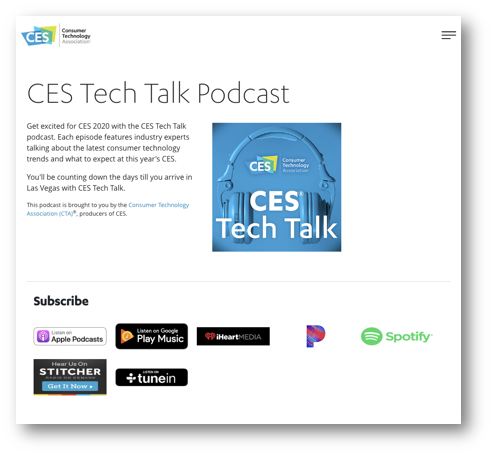
The CES Tech Talk Podcast is a great example of B2B content marketing.
Athena Health Teaches Business Skills Through Webinars
B2B Content Lesson: Help Solve Their Other Problems
I was recently asked by a client what kind of content they should be publishing for their audience that doesn’t give away the types of frameworks that they offer as part of their services.
While I actually believe you CAN give away some of your frameworks (see the next example), an effective type of content for B2B brands is acknowledging the kind that acknowledges that problem that your product or service solves isn’t the (only) one that’s keeping your client up at night.
For instance, Athena Health is a provider of a suite of services such as electronic health records (EHR) and medical billing. But they offer webinars that help their clients deal with their most critical business challenges: to improve the ways in which they run their practices, recognizing that doctors don’t necessarily have MBAs and don’t always know how to grow their businesses effectively.
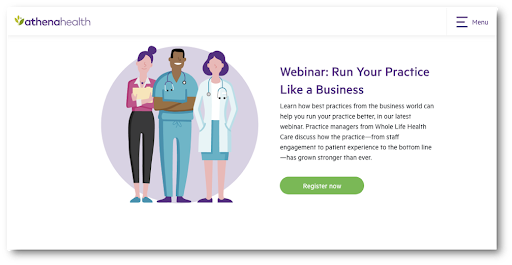
Webinars from AthenaHealth help their clients deal with their most critical business challenges — excellent example of B2B content marketing.
Convince & Convert (This Very Blog) Gives Away Tools & Frameworks
B2B Content Lesson: Provide Your Recipe to Build Trust and Authority
If you’re a regular reader of this blog, you may have noticed that we actually give you quite a lot of tools and frameworks that we use with our clients. That’s because we recognize that for B2B businesses like ours, there is a difference between the DIY segments and the segments that want you to help them take those frameworks and put them to good use for their organizations.
Therefore, we give away templates, like the one in this example, along with a video and blog post to explain to visitors how to use it. It builds trust, and when those visitors (maybe like you!) are ready to take their digital marketing practices to the next step, we are already at the top of their list in terms of trust and authority. Not only does it build trust, it also helps us to build an audience—content like this has great value in search.
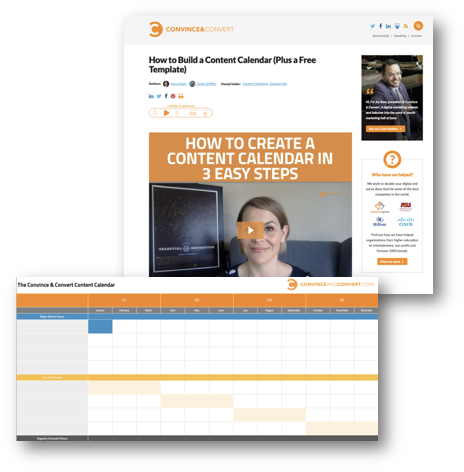
In this B2B content marketing example, we offer a downloadable template, along with a vide introduction.
Mailchimp Profiles Its Customers on Instagram
B2B Content Lesson: Showcase Your Community of Users
For many B2B companies, social proof takes the form of reviews or testimonials; however, as more and more B2B decision makers turn to social media, creating content that reflects your community is vital. In fact, 51% of all B2B customers turn to social media to do initial research, according to Accenture.
51% of all B2B customers turn to social media to do initial research.
Click To Tweet
Furthermore, the lines between social media and content marketing are blurring more than ever. More often than not, the content that our teams are creating live on social media channels, rather than on our websites. Therefore, looking at ways to create content within social media makes a ton of sense.
Mailchimp, for example, has used its Instagram account as a place to showcase the stories of what its customers are achieving every day, their creativity, and their stories to showcase the kinds of people who use Mailchimp to power their businesses. It publishes microprofiles on each Instagram post.
It showcases their ethos, and it reassures potential users that they’ve found their tribe.
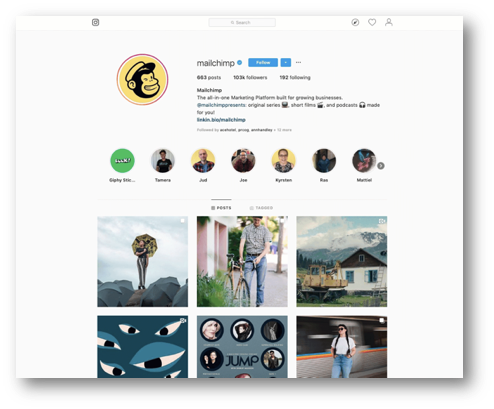
In this example of great B2B content, Mailchimp uses its Instagram account as a place to showcase the stories of what its customers are achieving every day, their creativity, and their stories to showcase the kinds of people who use Mailchimp to power their businesses.
CMI Facilitates Conversation Through Monthly Twitter Chats
B2B Content Lesson: Create Points of Interaction
If we’re talking about strong examples of B2B content marketing, what better place to turn that Content Marketing Institute itself? CMI not only educates marketers, but it also connects them through events like Content Marketing World.
An ongoing example of its content marketing practice is its monthly #CMWorld Twitter chat, where guests are invited to answer pre-selected questions, posed by a moderator, while Twitter users participate in answering those same questions, asking each other questions, and picking the brains of the guest. It’s like “Inside the Actors Studio” if the audience were up on stage participating too.
Not only does this approach create a strong network of devoted brand followers, but it (like our first example) helps the brand to leverage and extend its marquee brand. In this case, Content Marketing World’s #cmworld hashtag gets to be used once a week, rather than for one week a year. This keeps it front and center, when it comes to marketing conversations (their key market).
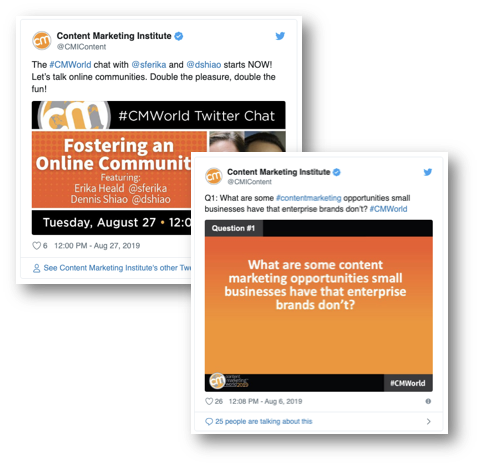
The #CMIWorld Twitter chat is an ongoing example of CMI’s content marketing practice.
Remember: As you’re developing your B2B content marketing campaigns, keep in mind your target audiences’ goals, challenges, and mindsets. If you are able to address those specific areas and make it easy for them to do so, your content will resonate and be effective.
The post 5 B2B Content Marketing Examples You Can Copy appeared first on Content Marketing Consulting and Social Media Strategy.



